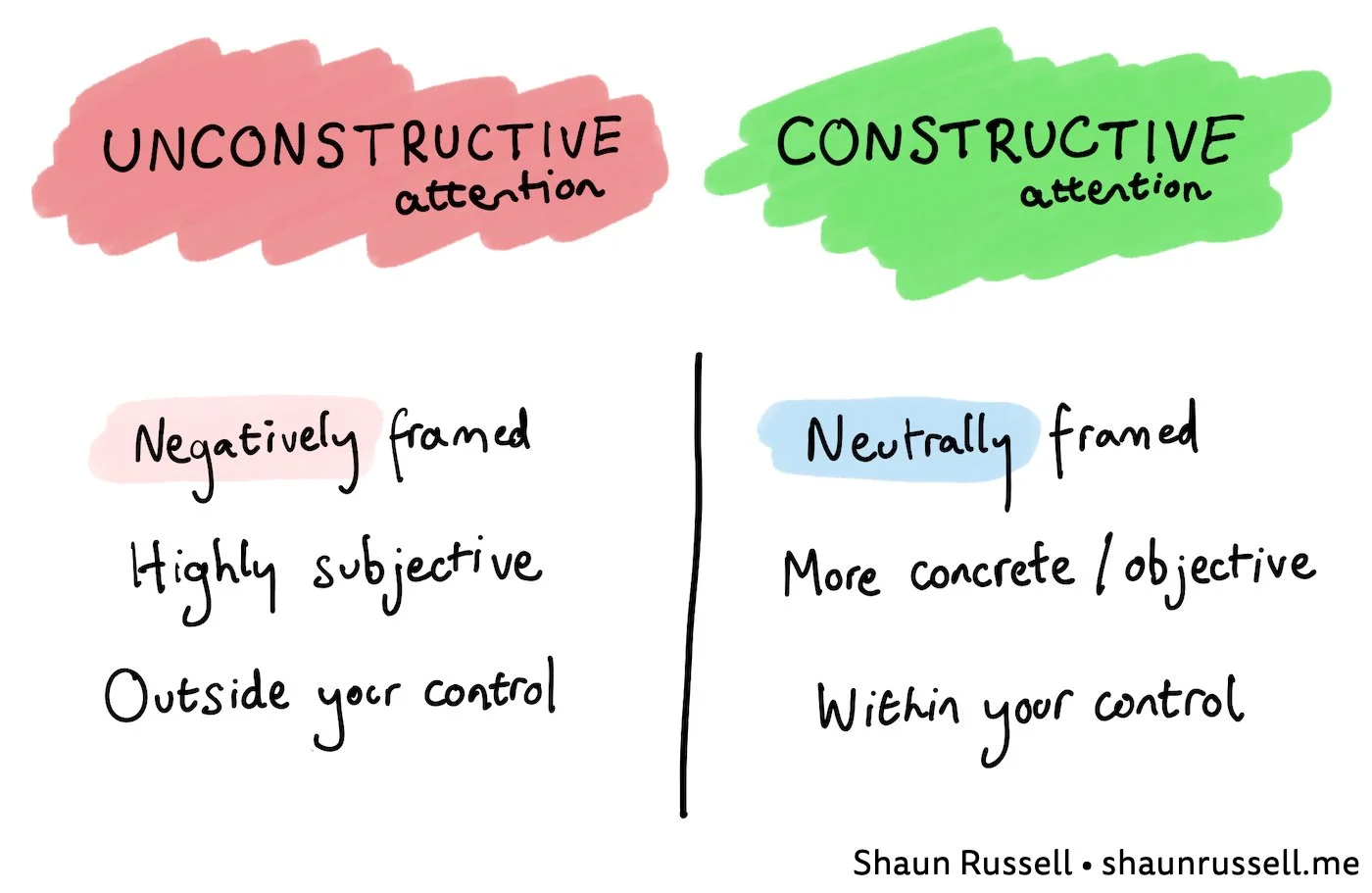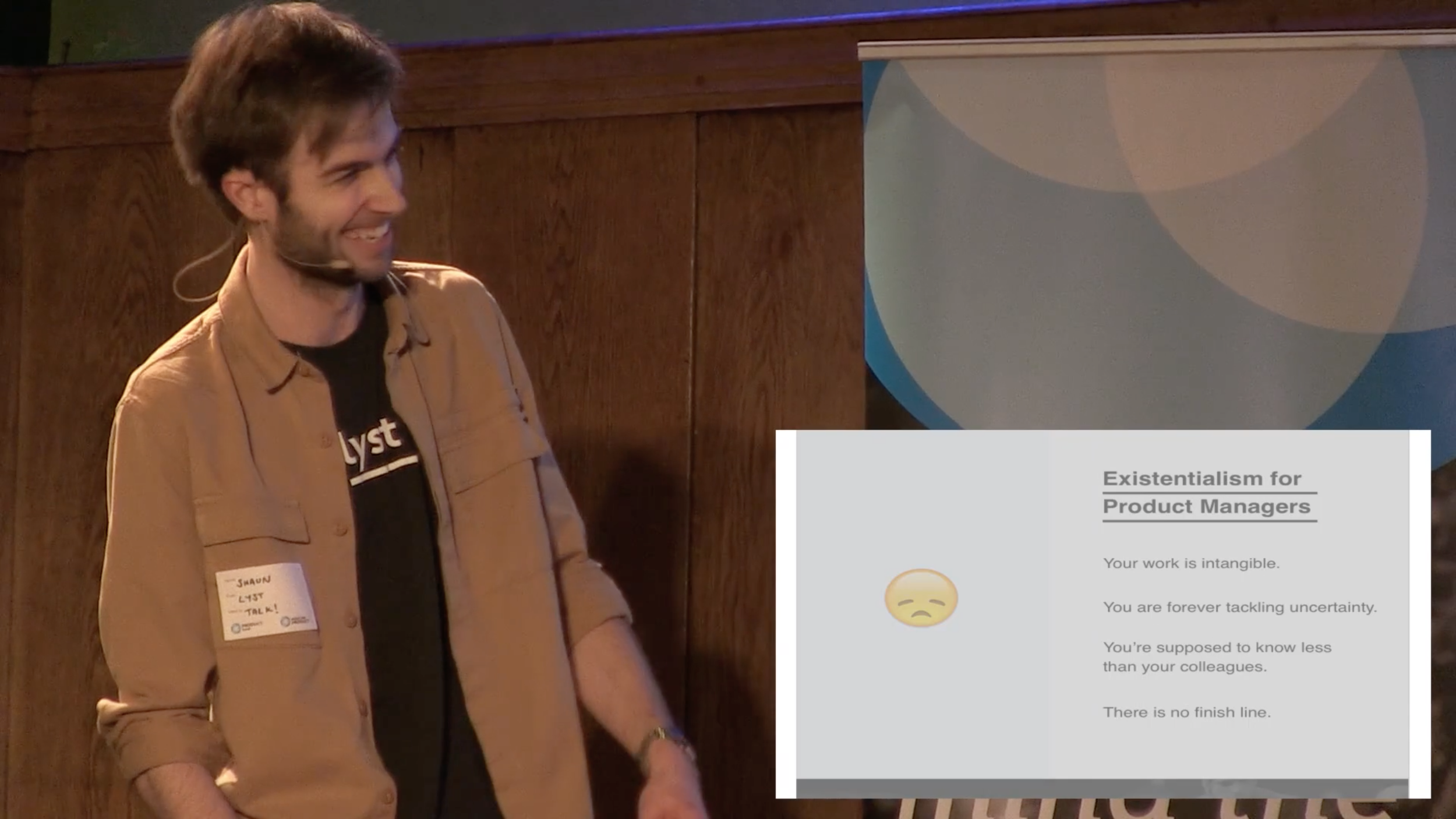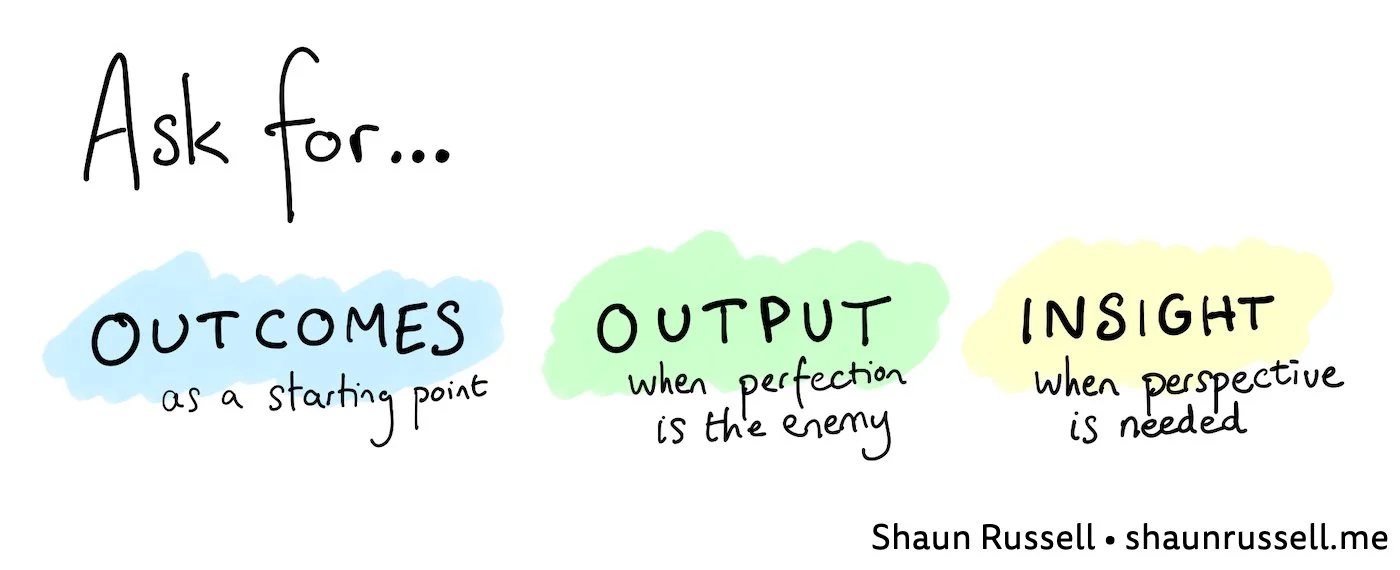How can you overcome self-doubt as a Product Manager?
If you are a Product Leader, how can you help others overcome their self-doubt?
It’s well established that working as a Product Manager is tough. The pressure is relentless. Your work is intangible and defined by uncertainty. You’re the only generalist in a team, surrounded by specialists, and everyone has an opinion on what you’re doing. It’s inevitable, then, that Product Managers suffer from self-doubt.
In this article, I will offer strategies for tackling self-doubt. I’ll begin by sharing a simple model that I use to explain how self-doubt works, and why it can be so hard to shake off. Then, using the same model, I show how you can overcome self-doubt by reframing attention.
I’ve written this not just to help Product Managers with their inner critic, but also to help Product Leaders coach their own PMs more effectively.
To start, let’s take a peek inside the mind of a Product Manager during a moment of crisis and ask: what’s going on in there?
the Vicious Cycle of Judgment and Attention
Meet Paisley the Product Manager. Since last quarter, Paisley has been holding monthly meetings to update stakeholders on her team’s progress. The next meeting is today.
She feels like these meetings are not going well. The thing is, it’s not for lack of preparation, nor the quality of her work. Her team is making good progress. But, a few hours before the meeting, she’s already thinking about all the ways in which it might go wrong. She thinks about how inexperienced she is, and what the stakeholders really think of her. She imagines her nightmare scenario: a totally unexpected, difficult question, that she doesn’t know how to answer.
So, when Paisley starts a meeting with this mindset, what does she pay attention to during the meeting?
She pays attention to how small her voice sounds, and notices every time she stumbles over her words. She pays attention to her stakeholders, and whether they look unimpressed by her. And she’s still paying attention to that nightmare scenario in her head – the unexpected question – and how it could happen at any moment.
Paying attention to these things doesn’t help. When she thinks about stumbling over her words, she is more likely to stumble, rather than less. When she scans for unimpressed faces, she finds grumpy stakeholders, and feels discouraged. And when she worries about an unexpected question, she is worrying about a scenario that, by definition, is totally outside her control and impossible to prepare for.
We can think of these ways of paying attention as unconstructive attention. When we enter a situation with self-judgment, we tend to pay attention to things that confirm our view. We gather evidence that we’re not good enough. The mindset of self-judgment leads us to unconstructive attention, which leads to more self-judgment, which leads to more unconstructive attention. This is how we experience self-doubt. It’s a vicious cycle.
Once we enter into the vicious cycle of self-doubt, it’s hard to get back out
This cycle is also reflected in our everyday language, when we say that someone is “spiraling”. If we want to overcome self-doubt, we need to interrupt the pattern.
Turning a vicious cycle into a virtuous one
Mistakenly, popular wisdom is to focus on the left hand side of the vicious cycle. To reduce your self-doubt, as the inspirational posters claim, you simply need to believe in yourself:
An adorable kitten transcending the vicious cycle of judgment and attention
I have to admit that, as a coach, I still occasionally make this mistake. When someone has self-doubt, it feels logical – necessary, even – to encourage them to believe in themselves more.
But if self-judgment is the problem in the first place, telling someone to just not do that is useless and, frankly, absurd advice. Using our model of the vicious cycle, we can also speculate that it might make the problem even worse. It’s simply another variety of unconstructive attention, outside of their control. The Product Manager focuses on whether they can magically rid themselves of self-judgment. When they fail to do so, and encounter self-doubt, they have no-one to blame but themselves.
Fortunately, there is an alternative approach. We can try to intervene on the right-hand side of the diagram: how we direct our attention.
In the example of Paisley, I described her focus as unconstructive attention. She paid attention to things that were negatively framed, highly subjective, outside her control, or self-fulfilling in nature.
Instead, we can encourage constructive attention. This is when you focus on things that are neutrally framed, more concrete or objective, and within your control. When we shift focus like this, we are reframing attention, or for short, reframing.
Reframing from unconstructive to constructive attention
One of the most impactful reframing moments I’ve experienced was on 20th January 2016, hours before my first ever public presentation about product management, at ProductTank London.
I was a bag of nerves. I thought my talk was going to be awful. With a few hours to go, I had a practice run-through with Matt Buckland, a senior colleague of mine at Lyst. Rehearsing in front of him, I felt ashamed at how bad it was, and dreaded the feedback he was about to give. But Matt did not offer me feedback. Instead, he asked one simple question: “Do you feel like you’re giving good advice?”
The answer was immediately obvious to me: yes. I really believed in what I was saying.
Before he asked me, I was overwhelmed by the vague feeling that my talk was not good enough (and on a deeper level, that I was not good enough). My focus was negative, and hard to pin down. Matt’s question reframed my attention to something concrete and constructive. And if my answer had been no? Then it was within my realm of control: having identified that weakness, I could have improved my talk.
With Matt’s reframing at the front of my mind, the final presentation went better than I could have imagined. I was confident, felt a real connection to the audience, and received glowing feedback. It was a simple question – but it pulled me out of the spiral.
Eagle-eyed readers may notice that I already wrote the introduction to this article 6 years ago
So, to break the cycle of self-doubt, we need to reframe attention constructively. But beware: it’s not as easy as it looks…
Feeding the Judgment Monster
When you see someone struggling, it feels like common sense to offer advice or feedback. In principle, if we can do this constructively, then this is a valid, helpful way to reframe someone’s attention. But in practice, if someone is stuck in a cycle of self-doubt, it is difficult to do without making the problem even worse.
Why is this? Firstly, when people give feedback, they often express it in a way that contains judgment. They make normative statements, claims that contain words like should or must:
You should speak more clearly
You shouldn’t commit to deliverables upfront
You must stand up for what your team needs
You should ask your stakeholders clarifying questions
Each of the above could be a valid recommendation, and helpful in the right context. But, because they are normative statements, they also contain criticism. “You should speak more clearly” suggests that you speak unclearly. “You should stand up for your team” suggests you are a pushover. Despite the best intentions, such implied criticism is likely to reinforce the self-doubt.
There is an even deeper level to the problem. Feedback doesn’t just depend on how it’s given, but also on how it’s received. People are sensitive and perception is subjective, especially for someone who is vulnerable. So, even if we take great care to give non-normative advice, someone with overwhelming self-doubt is primed to hear judgment in it.
Just because you think your feedback is a gift, doesn’t necessarily make it so
For example, the Product Leader may give the following innocuous advice:
“If you receive a difficult question, try asking the stakeholder to clarify what they mean and why they are asking.”
The Product Manager, spiraling in self-doubt, hears something different:
“They think I’m a bad Product Manager. I always panic when I’m asked something. I forget to ask stakeholders basic questions.”
These problems can also play out without a feedback giver, entirely inside the head of the Product Manager. How often, when trying to do something, do we issue ourselves instructions on what we should and shouldn’t do? And then, when we make a mistake, we curse under our breath, repeating our self-judgment: ugh, don’t be such a pushover, or I always make that mistake. We’re like a football or tennis player that admonishes themselves in the middle of a match. The commentator might remark that the player has “lost their head”. It’s rarely a good sign.
You might be thinking that all of this seems very irrational. That’s because it is! When you’re in the cycle of self-doubt, you experience a different reality. But that is not a sign of madness. It’s a simple consequence of human nature, and the very demanding role of a Product Manager.
So if giving advice is problematic, what alternatives are there?
3 methods to reframe the product mind
Taking inspiration from The Inner Game of Tennis (a wonderful book about coaching mental performance), I propose for the following 3 methods for reframing attention:
Ask for Outcomes
Ask for Output
Ask for Insight
You can use each of these methods whether you’re trying to help yourself, or coach someone else. Let’s walk through each one in turn.
1. Ask for outcomes
When we Ask for Outcomes, we ask the Product Manager: what is the intended outcome of this work? Are you on track to deliver the outcome? If not, which course of action would be most likely to deliver it?
Take our example from earlier, Paisley the Product Manager. As a first step, she needs to identify the intended outcomes of her stakeholder meeting. Is it to keep stakeholders informed and up-to-date? Is it to ensure that she solicits key decisions from her stakeholders? Or is there something else?
During the meeting, she should pay close attention to these outcomes, and whether they have been met. If the answer is yes, she can be satisfied with a job well done. If the answer is no, then delivering this outcome becomes the focus of her attention (rather than worrying about unexpected questions, or the grumpy face of a stakeholder).
Sometimes, Asking for Outcomes seems mundane or too obvious. But, it is surprising how often this intervention brings clarity and confidence to a situation. That is why, when in doubt, it’s where I like to start.
2. Ask for Output
Sometimes an outcome focus is overwhelming. We’ve all stared at an empty page, struggling to write the first line of an important essay. Self-doubt tells us that our work won’t be good enough, and stops us from trying and learning from our mistakes.
When we Ask for Output, we are temporarily changing the rules of the game. We establish that quality is not important, and no outcomes are expected for now. Instead, the Product Manager only has to complete a small task, usually a first draft of a deliverable, to get started.
To further encourage unfinished work, we can introduce limitations. For example, Matt LeMay suggests limiting a draft to a maximum of one page and one hour, at which point you share your work with colleagues. He calls this “incomplete by design”. Or we could go one step before a draft, and ask for a brain dump: write down everything you’re thinking, that is somehow relevant to the deliverable, until your mind is empty.
This method has many applications. People often convince themselves they lack theory or insight, when their real problem is an unwillingness to try. Take the topic of product strategy. There are a huge number of strategy books and frameworks. But the most common problem I’ve observed isn’t a lack of theory. It’s that people go to great lengths to avoid writing a first draft which exposes their thinking. (Maybe this is why there’s so much demand for strategy books – it keeps people busy!)
Finally, when you Ask for Output, it’s important that you actually mean it. If you’re going to tear into someone’s work, don’t push them into writing under false expectations. Trust is also crucial. If the Product Manager doesn’t trust the coach, they may avoid the task or close down altogether, as they perceive the work, and your support, as a threat.
Nonetheless, when used in the right way, at the right time, Asking for Output can be an effective way to break the deadlock.
3. Ask for Insight
Sometimes asking for outcomes is not enough, and asking for output is unhelpful. Instead, we can Ask for Insight: ask probing questions that will help the Product Manager see their challenge from a fresh perspective.
Sometimes, quite generic questions can help break the cycle. For example, when the Product Manager is stuck on a problem, you can ask:
Why has this problem arisen?
What could the root causes be?
What might you do to understand more about this problem?
In what ways could you address the problem?
Or, imagine a Product Manager is deeply unhappy with a stakeholder decision, and struggling to address the conflict. Here, it can be invaluable to encourage empathy with questions like:
What reasoning (or beliefs) could explain the stakeholder’s decision?
What information might you be missing from the picture?
If you were in their position, with their responsibilities and information, what would you do?
If you are the Product Manager, you can Ask for Insight by setting aside time to identify which questions to ask yourself first. You also could share your situation with a trusted colleague, and ask them what questions they might ask themselves in such a situation. (Be explicit that you want questions, not advice). Wording is important, too. Research suggests that speaking to yourself in the third-person can improve emotional control. For example, instead of asking myself ‘How could I understand the problem better?’, I might ask ‘How could Shaun understand the problem better?’. However strange it sounds, this psychological distance may help you find perspective.
If you’re in the coaching role, it’s tempting to skip the questions, and go straight to the advice. The key, as we’ve established, is to avoid that temptation. If you have a solution in mind, then try working backwards, and identify questions that reflect your assumptions. I often find that these questions lead to a totally different conclusion than I expect. When giving advice from the outside, it’s easy to miss key parts of the picture.
Sometimes Asking for Insight helps the Product Manager acknowledge something they knew all along. Other times, they have a revelation and learn something totally new. It’s the most essential coaching tool of all, and a great way to reframe attention.
3 methods to reframe the product mind, and when to use them
get into the experimentation mindset
These are just 3 methods, and there are many more.
The truth is, reframing attention is messy and complex. It always depends on the person and their particular situation. Someone may be in so deep that it’s difficult to help them. If you’re trying to help someone else, your relationship to them also plays a critical role. Sometimes, something totally unexpected works (and you may never be able to explain why!)
Because it’s difficult to predict, my final recommendation is that you think of every reframing attempt as an experiment. Whenever you try to disrupt the well-trodden path of self-doubt, you’re doing discovery.
Last year, I started learning the piano. When I practice, I often find myself in the cycle of self-doubt. When I recognise this pattern, I experiment with reframing. What happens if I pay attention to the feeling of my fingers pressing the keys? What if I concentrate on my left hand, leaving the right to run on autopilot? What if I simplify the task, by playing the piece at half speed? What if I follow the path of the melody in my mind?
I’ve found that, even in such a controlled environment, what works one day, is different from what works the next. So, keep experimenting. You may be surprised by what you find!
conclusion
Self-doubt is a common problem for Product Managers. Whether you are a Product Manager or Product Leader, it’s useful to understand how it works, so that you can overcome it.
key points to takeaway
Self-doubt is a vicious cycle. Self-judgment leads to unconstructive attention, which reinforces self-judgment, and so the cycle continues on.
Break the cycle by reframing attention, changing focus from unconstructive to constructive (something neutral, concrete, and within the realm of control).
3 methods you can use to reframe attention:
Ask for Outcomes as a starting point
Ask for Output when perfection is the enemy
Ask for Insight when perspective is needed
Treat every reframing attempt as an experiment. Stay humble 😉
I hope this article helps you to navigate self-doubt in your own work. Give it a try. I’d love to hear how it goes.
– Shaun
further reading
The Inner Game of Tennis (book)
Chatter: The Voice in Our Head, Why It Matters, and How to Harness It (book) + Ethan Kross’ recent interview on The Happiness Lab
The Best Managers Don’t Fix, They Coach — Four Tools to Add to Your Toolkit
Asking for Outcomes: Outcomes Over Output (book)
Asking for Outputs: ONE PAGE / ONE HOUR
Asking for Insight: The Conflict Matrix






